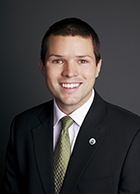For discussion
August 2013
Rural Development in North Dakota

Jasper Schneider, Director for USDA Rural Development (USDA-RD) in North Dakota, answers some questions for ND Compass about our state’s rural areas.
Q: In your tenure at USDA, what strategies have been utilized in improving our rural areas?
In a state like North Dakota, we are largely considered rural by USDA which means I’ve had the opportunity to work with communities of all sizes. Most of our counties are considered rural and our two largest industries, agriculture and energy production, are both very much rural industries. When I started at USDA four years ago, I set a sharp focus on building the state’s infrastructure to meet the demands of growth and on providing opportunities to areas of the state that aren’t seeing a lot of prosperity, leading us to invest over $2 billion during this time in loans, guarantees, and grants. Many of these resources were dedicated to building our water and electric systems to meet the demands of growth. At USDA, we have made it a priority to provide more of a local presence. Our team is working with tribal partners and communities of all sizes to offer technical assistance and help in reaching our goals.
Q: We’ve all read and heard a lot about the Bakken oil fields in Western North Dakota. Are there any specific rural issues in this part of the state we should be thinking about that are not currently being discussed?
The challenge of the tremendous growth in the Bakken is balancing economic growth with community vitality. North Dakota has always been a great place to live because of low crime, good schools, clean air and wonderful outdoor recreational opportunities. Some of that has taken a hit in our rural areas that are experiencing growth. We need to make sure we protect what is sacred and grow economically at the same time. This can be accomplished with strong leadership and a demand to have those concerns addressed. We need to ensure that they don’t get glossed over for the sake of economic prosperity.
Q: What are food deserts and how prevalent are they in rural North Dakota?
A food desert is an area where there is limited access to a grocery store or healthy nutritious foods. Despite North Dakota having agriculture as our largest industry, there are areas in our state that would be technically designated as a food desert. This is especially true in our more rural areas. USDA has been active in partnering with our smaller grocery stores and our local food groups to provide more options. This effort also helps keep dollars local.
Q: Which is more of a health problem in North Dakota, hunger or obesity?
Nutrition is the answer to both. Similar to food deserts, USDA has been active in working with schools and the general public to provide nutrition assistance and healthier food options.
Q: What are some of the successes you’ve seen with tribal communities in North Dakota? What do we still need to work on?
We recently issued a Tribal Progress Report highlighting our relationship with our tribal communities over the past four years. Our tribal areas have had great success with their tribal colleges and they continue to be a bright spot. We have also invested significantly in tribal infrastructure. Unfortunately, many of our tribal areas also have persistently high poverty rates which also signify spikes in crime and unemployment.
Q: How is USDA-RD addressing expanded access to high-speed broadband in rural areas? Do you think it will alleviate the pains of post office closures?
One of the accomplishments I am most proud of over the past four years is the historic investment we have made into deploying high-speed broadband Internet to our rural areas. This is 21st century infrastructure that is changing the way many rural communities interact, live and do business. I think if there is one thing that will permanently “change the game” for rural areas it is access to a high-speed connection. It takes away the digital-divide that has often plagued rural America and creates new opportunities to start a business or to telework. It also provides opportunities for distance-learning or telemedicine. As we look to the future of rural mail delivery, I imagine the Internet will play a role in that solution as well.
Q: What value do you think ND Compass has for the state of North Dakota? How have you used the site?
Sometimes we don’t know what we don’t know. ND compass helps bridge that gap by providing critical information. Many of the issues we focused on with the ND 2.0 report (such as housing, health care, invest in our kids) are prevalent on the website. I’ve appreciated ND Compass’ ability to provide even more information and detail to help raise awareness and meet the needs and challenges of a growing state.
Q: What do you see as the single biggest issue facing rural communities in North Dakota?
When we did the North Dakota 2.0 tour, we held regional town hall meetings in 14 different ND communities. We asked this similar question and overwhelmingly the response was: quality jobs. At USDA, we aim to make sure communities have infrastructure in place to not only support private sector job growth, but also to improve quality of life so it is attractive to live and work here. Another large issue facing rural areas is quality housing and childcare. Both issues impact the workforce. Many communities have jobs available, but if people cannot find a decent place to live and a quality safe place to send their children, they aren’t going to stay. We hear this from communities all over the state. The common denominator in all of this is local leadership. The communities that have it are meeting the challenges and thriving.
